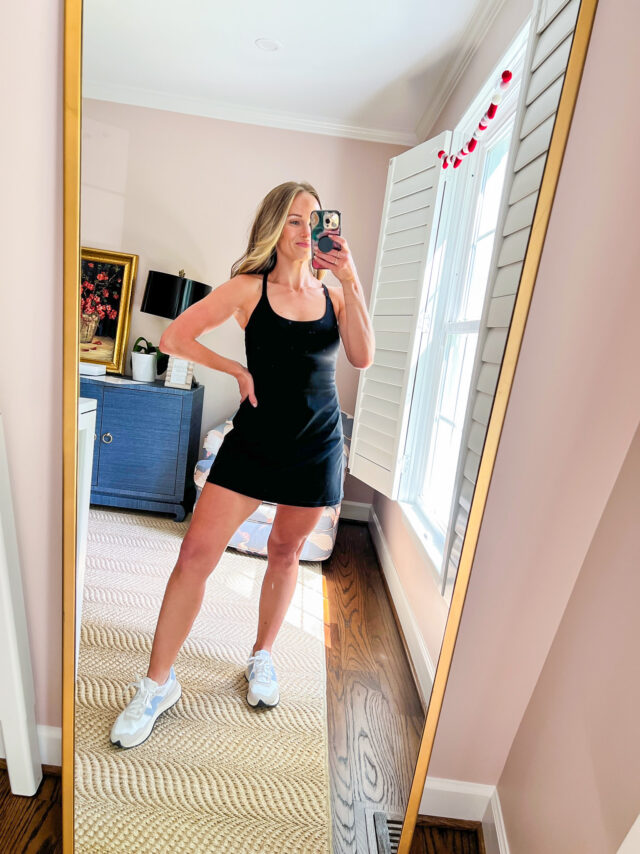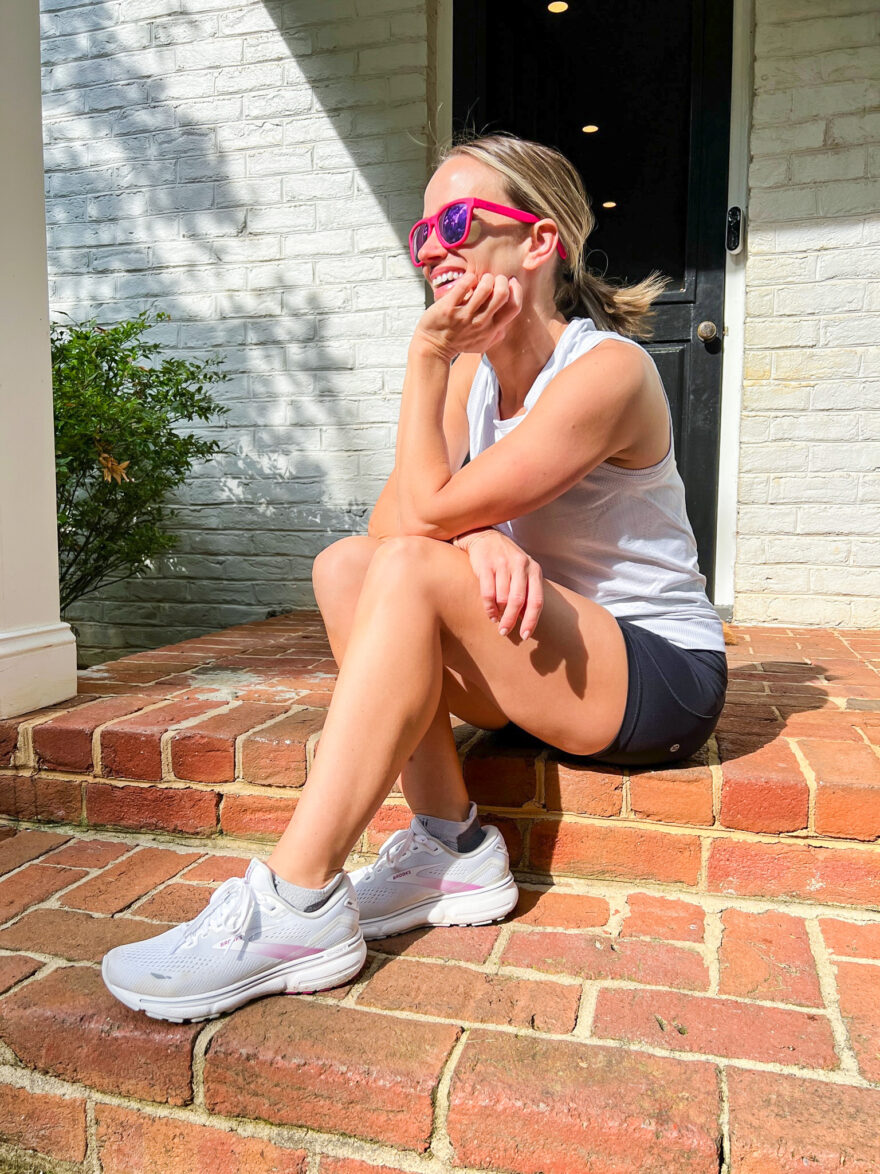

I’m very active. In an average week, I’ll run 3-4 times, do pilates and ride the Peloton. Usually doing a bike bootcamp for some strength training. Not to mention I chase my toddler around and going on regular walks.
While pilates and the Peloton have their own equipment, the most important gear when it comes to running and walking is the right pair of shoes. They help keep my feet and entire body, really comfortable. Also, the right shoes can also prevent injuries. It’s funny how walking and running seem like similar activities that work for the same muscle groups, but the truth is our bodies move differently with each one.
I’ve shared my favorite running shoes, but I’ve never dedicated a post to my favorite walking shoes. I’m not walking a lot these days since I no longer have a dog, my son doesn’t love the stroller and I’m not injured (thankfully). While I love walking, if I have to choose between a walk and a run, I’ll choose a run!
But, since I get asked about shoes quite often on my Rookie Runner Instagram account, I thought it’d be helpful to explain the difference.
As someone who has put in hundreds of miles (literally!) in both running shoes and walking shoes, I’ve noticed that there can a real difference between the two. I used to use my old running shoes for walking, rather than buying dedicated walking shoes. My PT pointed out that it may have been contributing to some injuries that wouldn’t heal. I dealt with plantar fasciitis for months. Also, I had a torn ankle tendon that still bothers me from time to time.) Just because there isn’t as much impact with walking as there is with running, it’s still important to not wear worn out shoes for your walks (whether you’re casually strolling or working up a sweat during a walking workout).
In general, most shoes designed specifically for walking have more cushioning and are usually heavier than running shoes. This extra cushioning helps support your feet and ankles when taking longer strides or having to cover more ground quickly. On the other hand, running shoes generally have less cushioning but are much lighter than walking shoes. The lighter weight helps reduce fatigue when pounding the pavement over long distances. But, what exactly makes the difference between walking shoes vs. running shoes?
Walking shoes are designed for comfort, more than anything. Shoes that are specifically designed for walking usually have a little heel cushioning. It helps absorb some of the impact that comes with walking. They don’t need extra forefoot cushioning in their shoes since you don’t toe off as hard as running. This design can potentially decrease injuries in the foot, ankle, and leg.
But, you don’t have to get big clunky, heavy shoes for walking – I mean, unless you want to! Those are in right now! Some of my favorite shoes for walking are lightweight and cute, but do have extra cushion in the heel. You can definitely use running shoes for walking, but you don’t have to. However, I would NOT use walking shoes for running!
Here are some shoes that are great options for walking. Some are true walking shoes and some are running shoes that I like for walking as well.
Running shoes are lightweight and more flexible but still provide sufficient cushioning. There are various types of running shoes, including neutral shoes with essential support and cushioning, cushioned running shoes with extra padding and motion-control, support shoes with additional arch support for things like pronation or recovering from injuries. Also, there are racing shoes, with high-tech materials like carbon plates, that are designed for going fast on race day (but not necessarily for everyday training and long runs). Then, there are also trail running shoes for exploring off-road.
Most types of running shoes have air or foam cushioning to absorb shock and protect against impact. The best running shoe for you will depend on your stride, running experience and running goals, but ultimately you’ll want what’s most comfortable and feels natural.
The right shoe will minimize impact (which helps minimize your risk of injuries), can help running feel easier and will definitely help you enjoy running more.
Choosing the right shoe size is important (unless you enjoy losing toenails) and most people will be happiest in a shoe that is 1/2 to a full size larger than their usual shoe size. I wear a size 6.5 in my sandals, Veja sneakers and heels but I go up to a size 7 in my walking shoes and a size 7.5 in my running shoes. They should be snug but not too tight and give your toes enough room to move and expand as you walk and run. A good rule of thumb is that you want a full thumb’s width between your longest toe and the end of your shoe.
I have a post with my favorite running shoes that you can read for more details, but they’re also linked below for easy reference.
Okay, so now that you know the basic difference between running and walking shoes, let’s talk about a few features to consider as you’re trying shoes on, whether for running or walking.
Appearance wise, there may not be much visible difference between walking and running shoes so being aware of these more subtle distinctions can help you decide which type of shoe you should wear.
The cushioning in walking and running shoes obviously helps with comfort, and it also helps reduce the shock when the foot first strikes the ground.
What runners need: Running shoes typically offer more cushioning than walking shoes due to the higher impact forces associated with running compared to walking. Most running shoes have cushioning spread across the shoe’s sole as it needs to absorb higher amounts of force. A thick midsole doesn’t necessarily mean it has more cushion, but that can be true, like in the case of Hokas. It just depends on the cushioning technology used for how thick the midsole will be. If you want a lot of cushion, this blog post about Hoka Walking shoes is helpful!
What walkers need: Walkers often use a heel-first strike pattern when taking each step, so the cushioning in these shoes is concentrated mainly in the heel region rather than evenly distributed throughout.
What runners need: Running shoes are lighter, which will be more comfortable given the faster foot turnover associated with running. Running shoe manufacturers use different types of cushion or use fewer cushioning layers to help reduce weight. My husband was running in New Balance lifestyle shoes for months before he invested in true running shoes and the first thing he said after his first run in his Brooks Ghost was that it felt so much easier.
What walkers need: In contrast, hiking or trail-type walking shoes usually have thicker treads. It has extra padding layers to protect your feet from whatever terrains you encounter while walking. Even though these features often make hiking or trail-type walking shoes more comfortable than running shoes, they can also add unnecessary weight and bulkiness. Those features are helpful for hiking, protecting your feet and stabilizing your ankles on uneven surfaces. Nonetheless, they can restrict natural movement when trying to move quickly while walking or running. (If you want to run on trails, buy trail running shoes like the Brooks Cascadia; don’t try to run in hiking boots or even most hiking shoes!)
What runners need: Running shoes have a higher heel stack height for cushioning and stability during heel strikes. Additionally, running shoes have a heel flare (i.e. wider in the back) for stability and control when you hit the ground.
What walkers need: Walking shoes have less of a built-up heel. A lot of people like zero-drop shoes for walking (and even running) since they mimic your natural stride. I particularly like Altra for a zero-drop option.
A shoe’s flexibility level should be considered when deciding which one to buy, as it can significantly impact movement.
What runners need: Side-to-side stability and more flexibility for faster movement and more front to back movement. The design of a running shoe’s sole allows for smooth and efficient movement from when the foot touches the ground to when it pushes off.
What wakers need: Walking shoes have a more rigid construction than running shoes, which provides even ore stability. If you held a pair of walking shoes, you’ll notice there is more resistance. It’s harder to twist or bend at the sole since it has less flexibility compared to a running shoe, if you tried the same thing.
Arch support is critical when selecting your footwear, as it provides balanced support and prevents injuries. Depending on your biomechanics, you will want to look for help or neutral shoes that best suit your needs.
What runners need vs. What walkers need: Arch support in most walking shoes tends to give more cushion. It is how the weight of each step is distributed throughout the entire foot during walking versus running. That being said, your best options is getting fitted properly by a trained professional. This is to ensure you get the right level of arch support that best fits your biomechanics and feet. Companies like Fleet Feet has software that will analyze your foot size, shape and stride. All you have to do is stand and walking on specialized pads designed to measure.
When considering arch support, there are a few key elements to remember. First and more important – it should be comfortable. It shouldn’t feel too tight under your arch or feel like it’s rubbing in a weird spot . It’s the case since that can cause blisters. Second, the right arch support helps put your foot in the right spot. This is so your feet are protected and stride most naturally. Lastly, consider inserts. I don’t think everyone needs inserts. However, they absolutely can help in certain instances, depending on your ankle stability and how a shoe fits you.
Yes, absolutely. But I wouldn’t wear true walking shoes for running. I prefer to have separate shoes for running and walking. However, realistically what happens is that I start using my old running shoes for walking. That’s not idea since they have lost cushion. But they usually give me a few more months of out a pair of shoes that I no longer want to run in but don’t want to get rid of yet.
At the end of the day, it’s really up to you. If you were going to get just one pair, I’d go for the Brooks Ghost. I’ve had multiple pairs that work well for both running and walking. They’re comfortable and easy to find!

It all comes down to what you’re most comfortable in while running and/or walking.
Shop The Post


Leave a Comment